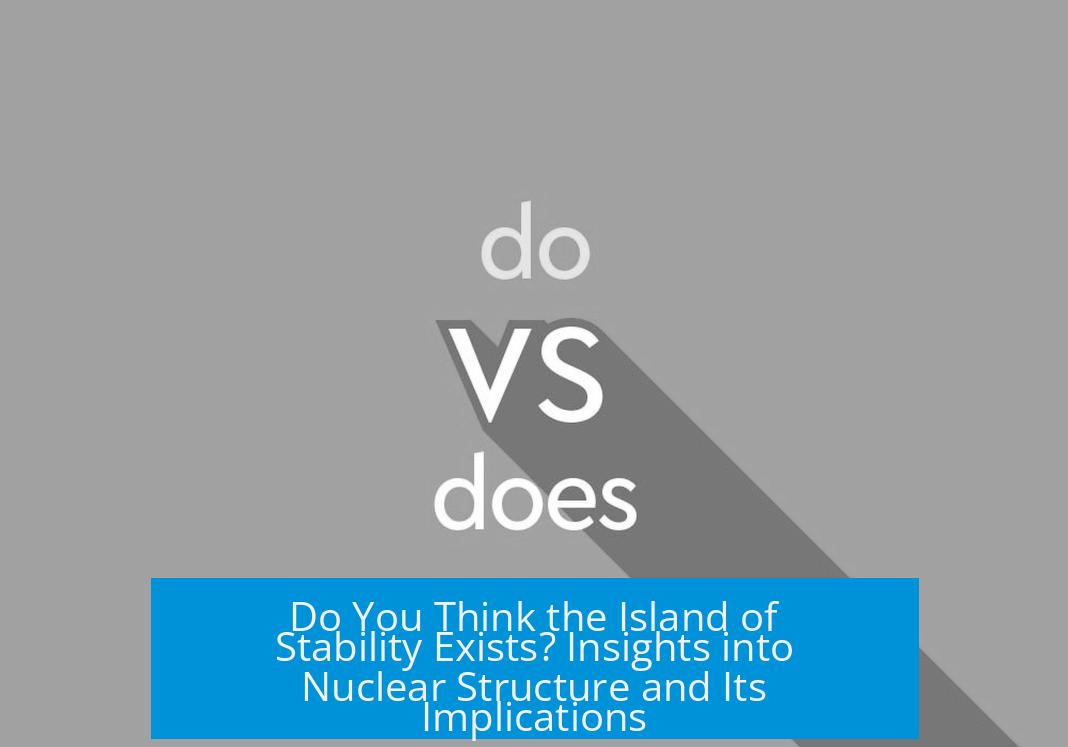Does the Island of Stability Exist?

The island of stability likely exists as a predicted region in the nuclear chart where superheavy elements exhibit enhanced stability due to nuclear shell effects. This region contains nuclei with certain “magic numbers” of protons and neutrons, resulting in relatively longer half-lives than neighboring nuclei. However, these half-lives are still expected to be short, mostly in the range of milliseconds to seconds, rather than years or millennia.
Understanding the Island of Stability

The Nuclear Shell Model and Magic Numbers

The concept of the island of stability originates from the nuclear shell model, which describes the structure of atomic nuclei similarly to how electron shells govern atomic behavior. In this model, protons and neutrons (collectively called nucleons) occupy discrete energy levels or orbitals.
Like electrons, nucleons fill orbitals according to the Pauli Exclusion Principle, which allows a maximum of two nucleons with opposite spins per orbital because nucleons are fermions with half-integer spins (+1⁄2 or -1⁄2).
“Magic numbers” arise when nucleon numbers fill completely filled energy shells, producing significant energy gaps between filled and unfilled orbitals. These filled shells confer special stability on the nucleus. Common magic numbers for nucleons include 2, 8, 20, 28, 50, 82, and 126.
For example, oxygen-16 (8 protons and 8 neutrons) and calcium-40 (20 protons and 20 neutrons) are very stable nuclei because both proton and neutron numbers match magic numbers. Such nuclei resist radioactive decay and possess increased binding energy.
Magic Numbers Differ for Protons and Neutrons

It is important to note that protons and neutrons have distinct sets of orbitals and energies within the nucleus. Thus, “double magic” nuclei are characterized by both proton and neutron numbers being magic. These nuclei are exceptionally stable compared to their neighbors.
Changes in Magic Numbers with Increasing Nuclear Mass

As we explore heavier elements, the nuclear shell structure becomes more complex. At higher nucleon numbers, the energy gaps between shells decrease, resulting in less pronounced magic numbers. This leads to fewer strongly stable configurations for heavy and superheavy elements.
The reduced gap means that larger nuclei typically have less shell stabilization, and their proximity to magic numbers is less common. Consequently, the likelihood of very heavy nuclei being doubly magic diminishes.
What is the Island of Stability?
The island of stability is a theoretical prediction of a cluster of superheavy nuclei centered around a set of proton and neutron numbers where shell effects combine to create enhanced stability. Usually, this region is expected near a proton number of around 114 or 120 to 126 and neutron numbers near 184.
Despite their large atomic numbers—far beyond those of known elements—the shell closures are predicted to create relatively stable combinations that can’t be entirely ruled out.
The term “island” refers to this compact region within a vast “sea” of highly unstable nuclei that rapidly decay. This concept suggests some superheavy nuclei might live much longer than their unstable neighbors.
Challenges in Predicting Stability and Lifetimes
One critical question remains: what exactly does “relatively stable” mean for nuclei in the island of stability? Predicting exact half-lives is challenging because these nuclei have not yet been fully synthesized, and theoretical calculations vary.
- Half-lives might range from milliseconds to potentially seconds or longer.
- Lifetimes measured in years or millennia currently have no theoretical backing.
- Even milliseconds represent a substantial improvement over superheavy elements synthesized so far, some lasting only nanoseconds.
- Technological limitations render the synthesis of elements with proton numbers around 150 or beyond currently impossible.
Thus, the statement “relatively stable” reflects a comparative advantage over known superheavy nuclei rather than absolute long-term stability.
Modern Understanding and Experimental Progress
Elements up to atomic number 118 (oganesson) have been synthesized, but their half-lives are generally fractions of seconds or lower. Experimental attempts to reach the island of stability must extend to possible elements with much higher proton numbers.
Research shows that nuclear shell effects may evolve or fade as neutron-to-proton ratios shift in heavy nuclei, making empirical verification critical. Scientists observe if new magic numbers emerge or previously known ones weakens far from stability.
The Island’s Scientific and Practical Value
While the island of stability promises nuclei with longer half-lives, this does not imply practical applications are imminent. Elements within this island:
- Are unlikely to form bulk materials or metals due to short lifetimes.
- Will decay too rapidly for chemical characterization or use.
- Will primarily advance understanding of nuclear forces and quantum mechanics.
Discovery of such nuclei would enrich nuclear physics but will not drastically impact technology or industry soon. New elements will update the periodic table and extend theoretical frameworks but remain mainly academic.
Summary of Key Points
- The island of stability is a predicted set of superheavy nuclei with enhanced nuclear shell stability.
- Magic numbers correspond to full nucleon shells, leading to greater nuclear binding and stability.
- Heavier nuclei have fewer pronounced shell gaps, reducing stability generally.
- The island centers near proton numbers 114–126 and neutron numbers near 184.
- Exact half-lives of these nuclei are uncertain but may be milliseconds to seconds.
- Currently, no experiments can fully access or synthesize these predicted nuclei due to technological limits.
- Stability gained on the island is relative; lifetimes remain short compared to lighter stable elements.
- The island’s discovery would advance nuclear science but offer limited practical benefits.
Do You Think the Island of Stability Exists? Let’s Dive Into This Nuclear Mystery
The island of stability does indeed exist, but it’s more like a tiny speck on the vast ocean of nuclear chaos—tiny, elusive, and far from yachting-worthy metals. Curious about why nuclear physicists get so excited about this “island?” Let’s unpack the science with a dash of humor and a pinch of curiosity.
First up, to understand the island of stability, you must meet the magic numbers and the nuclear shell model. Imagine the nucleus like a cozy apartment building where protons and neutrons (collectively, nucleons) prefer to settle into “energy levels” or “orbitals.” These orbitals are like rooms with different energy rents—1s, 2s, 1d, 2f, and others you won’t find in your typical electron shell rules.
Here’s a fun twist: nucleons have spin values of +1/2 or -1/2. Thanks to the Pauli exclusion principle, only two nucleons can share the same orbital with opposite spins. That’s why magic numbers are always even—no singles allowed in this energy party.
These magic numbers represent nucleon counts that lead to especially stable nuclei. A big energy gap between adjacent orbitals means nucleons end up snug in fully filled “rooms,” giving extra strength to that nucleus. Think of Oxygen-16 with 8 protons and 8 neutrons and Calcium-40 with 20 protons and 20 neutrons—both are very stable because their numbers hit these magic markers.
But what happens as nuclei get bigger and heavier? The gaps between these energy levels shrink, making it less likely to hit those perfect magic-number combos. Bigger nuclei tend to be more unstable and prone to radioactive decay—think of it as more crowded apartments where residents bump elbows a lot more.
Now the “island of stability” is the theorized archipelago of nuclei where these magic number combinations resurface in superheavy elements, suggesting a rare zone of relative stability amidst a sea of instability. In contrast to the quick-burst existences of the heaviest elements we’ve synthesized (which often last mere nanoseconds), those on the island could hang around longer—maybe milliseconds to seconds, possibly a little more.
Here’s where it gets tricky, and our crystal ball gets foggy: we just don’t know how long “relatively stable” truly is. Could it mean years? Days? Seconds? Most experts lean toward milliseconds-to-seconds, which is like winning a slightly longer round in a game of nuclear roulette. Still, compared to elements that blink out in nanoseconds, that’s practically an eternity.
One catch: the island is expected to be somewhere near atomic numbers in the 150s, way beyond the heaviest element we’ve synthesized so far, which is element 118, Oganesson. This means synthesizing these nuclei is way beyond today’s tech. So unless we clone a mad science lab from the future, we won’t hold these “island metals” in hand anytime soon. Don’t hold your breath—or your periodic table updates.
What about practical significance? Well, a lot of nuclear scientists view the island of stability in mainly academic terms. Winning a scientific jackpot sounds fun, but an element that lives several seconds still doesn’t make a chunk of metal you can turn into jewelry. The half-life won’t be years or centuries, so practical applications are slim. The breakthroughs would be more about understanding nuclear forces, shaping nuclear models, and boosting fundamental physics than revolutionizing material science.
But why do we care about an island so fleeting it might make a soap bubble envious? Because each discovery nudges us closer to understanding nuclear forces and stability. The evolution of magic numbers in extreme conditions challenges our models and helps refine them. Sometimes, science advances by knowing what doesn’t stick around long enough to matter.
If the island of stability becomes reality, it’s likely we’ll mark it as a nerdy milestone. Researchers will bask in their triumph, textbooks will be edited, and the periodic table will get a fancy new row. But for the everyday world? Don’t expect to see new super-heavy metals in your phone anytime soon.
Still, this doesn’t make the island of stability any less fascinating. It’s a cosmic challenge, a nuclear Rorschach test pushing physicists’ understanding to the limit. Scientists ask, what if, can we, and will it matter? In the meantime, the island stands as a beacon for experimental physicists and theoreticians alike—a quest for elusive stability in the wild seas of nuclear matter.
So, do you think the island of stability exists? If by “exist” we mean a real zone where certain superheavy nuclei last longer than a blink, yes, it exists. If you expect those nuclei to be Earth-shattering, metal-forming, or life-changing, well, not quite. It’s a cool scientific curiosity—one that makes you appreciate the nuclear world’s complexity and keeps the quest for knowledge alive.
Now, next time you look at the periodic table, pause a moment and imagine: somewhere, far beyond element 118, lies an island of fleeting stability waiting to be uncovered. And that’s a pretty exciting thought.
What is the “island of stability” in nuclear physics?
The island of stability refers to theoretical nuclides with magic numbers of protons and neutrons that are more stable than surrounding heavy elements. These nuclei lie in a region of the periodic table where stability peaks despite very high atomic numbers.
Why do magic numbers matter for nuclear stability?
Magic numbers correspond to filled nuclear shells, creating large energy gaps that lead to extra stability. When both proton and neutron counts reach these numbers, the nucleus tends to be significantly more stable than its neighbors.
Do heavy, superheavy elements have magic numbers and stability?
As nuclear mass increases, the energy gaps between orbitals shrink, reducing chances for magic-number stability. Still, theory predicts magic-number combinations exist even for very heavy elements, forming the island of stability.
How stable are the elements predicted in the island of stability?
Current science cannot precisely predict their half-lives. Estimates range from milliseconds to possibly seconds. Even these short-lived nuclei would outlast known superheavy elements, which often decay in nanoseconds.
Will elements from the island of stability have practical uses?
Probably not. Their half-lives are too short for real-world applications. Discovering them would be mostly academic, updating nuclear models but unlikely to affect technology or materials science significantly.





Leave a Comment